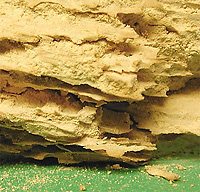
03 Aug 2015 Climate Change and the Historic Fowler Clark Farm
In June guest blogger/architect/Boston resident Susan Pranger wrote about the potential future impacts of climate change on historicbuildings. In part two of her blog, Sue discusses possible climate-related damage to wood at the 1786 Fowler Clark Farm in Mattapan, which was recently acquired by HBI. Her next installment will discuss possible strategies to mitigate future damage to historic fabric at the Farm.
To limit future damage to the c. 1800 Fowler Clark Farmhouse, it is helpful to understand how changes in temperature, solar intensity (UVB), humidity and rain patterns can increase the rate of weathering and deterioration of wood structures from moisture, rot, fungus and insects.
The 2013 structural inspection by Structures North indicates that the original c.1800 hybrid timber framing is softwood and has extensive damage from powder post beetles, some recent. The increase in temperature and humidity projected in New England can make wood more attractive to microorganisms that are capable of biodegrading the wood and can also create a habitat more favorable to the insect, allowing their numbers to increase or causing the boundaries of their habitat to decrease, enlarge or shift.
Different species of both hardwood and softwoods perform differently due to variations in density and the type of chemical extractive. Oldgrowth wood, as in the c. 1800 timber frame, is denser, and therefore more resistant to moisture damage than new lumber
 |
Each species of wood has a unique complex chemical extractive that affects color, resistance to water, fungal decay and insect attack, swelling and shrinking.Water soluble extractives can be washed from wood by rain, and other extractives may be degraded by sunlight. Although the deterioration of the surface by UV and moisture is slow, as little as ?? in a century, it can cause micro-checks that eventually split the surface and allow water penetration. Deterioration caused by UV-B can increase when combined with higher temperatures and high ambient humidity. Additional investigation is required to identify species of the Farmhouse.
Wood is not very porous, so short term exposure to moisture will typically affect only the surface.However in a heavy rain, wood will absorb water until the capillaries are saturated and create a film that runs down the surface penetrating cracks and joints, increasing risk of deterioration. Prolonged exposure can affect the dimensional stability and durability of coatings, and promote fungal attack and decay. The increased intensity and frequency of rain that is predicted can also increase cycles of wetting and drying, which is more damaging when the cycle is rapid, repeated, or combined with freezing or extreme dry or hot spells eventually causing the fibre to fibre bonding to fail so that splits and checks develop.
Wood characteristic are also influenced by moisture, temperature and wind during growth and how the wood is harvested, dried, and milled. For example, older buildings used refuse boards with wavy edges for sheathing, which allowed moisture to escape through the gaps. Hand split (riven) shingles follow the grain of the wood and traditionally were smoothed after splitting. Sawn shingles used today have an open end grain that makes them more likely to absorb water and cup.
The required renovations to the Fowler Clark farmhouse provide a unique opportunity to incorporate strategies to mitigate future climate stress by designing the site and exterior envelope to be resistant to wind and moisture, and to protect the interior timber framing from moisture and insects.
?Lyctid powderpost beetle damage looks like fine flour. Lyctid powderpost beetle holes are very small, about 1/16 inch…? (EPest Supply n.d.)
 |
| Anobiid powderpost beetle damage looks like tiny gritty pellets |
Sources:
Andrady, Anthony L, Hamid S. Hamid, and Ayako Torika. 2003. “Effects of Climate Change and UV-B on materials.” Photochem. Photobiol. Sci, 68-72. doi: 10.1039/B211085G.
Pest Control. http://www.adamspestcontrol.com/residential-pest-information-crawling-insects-powder-post-beetles.
Carmeliet, Jan, and Bert Blocken. 2004. “Rainwater Runoff for Evaluating Water Leakage Risks in Building Envelopes.” Oak Ridge National Laboratory. http://web.ornl.gov/sci/buildings/2012/2004%20B9%20papers/196_Carmeliet.pdf.
Company, David Williams. 1905. “David Williams Company.” Building Age.
EPest Supply. n.d. “How to Kill and Get Rid of Powderpost Beetles.” EPest Supply. http://www.epestsupply.com/powder-post-beetles.php#.VSK5OspFDYU.
Lubeck, Aaron, and Francis Conlin. n.d. “Efficiency and Comfort through Deep Energy Retrofits: Balancing Energy and Moisture Management.” Journal of Green Building, Vol. 5, Number 3.
Regniere, J. 2009 . “Predicting insect continental distributions from species physiology.” unasylva Adapting to Climate Change 60.
Safeguard. Dry Rot and Its Control. http://www.safeguardeurope.com/applications/dry_rot.
Simpson, J.W., and P.J. Horrobin. 1970. The Weathering Performance of Building Materials. Medical and Technical Publishing Co Ltd.
Structures North. 2013. “Letter re: structure of Fowler Clark Farm.”
“Timber Construction.” boingconsult.com. http://www.boeingconsult.com/tafe/mat/Timber/HowTreeGrows-OH.htm.




